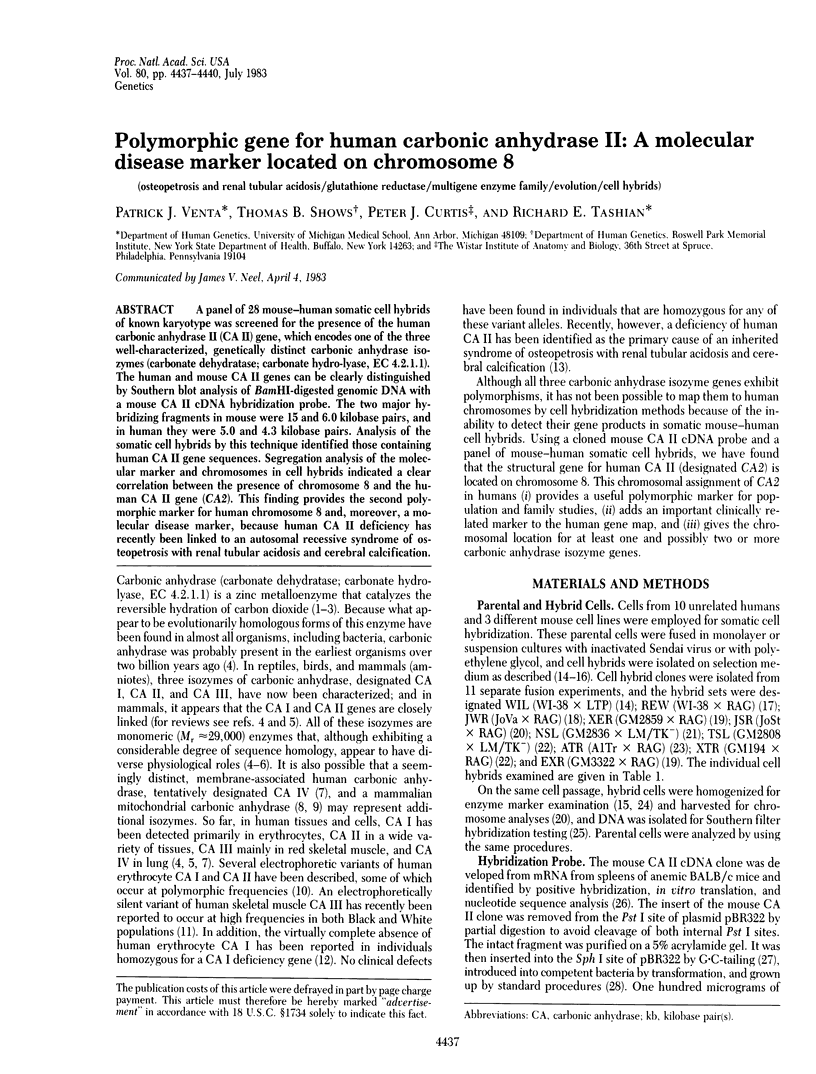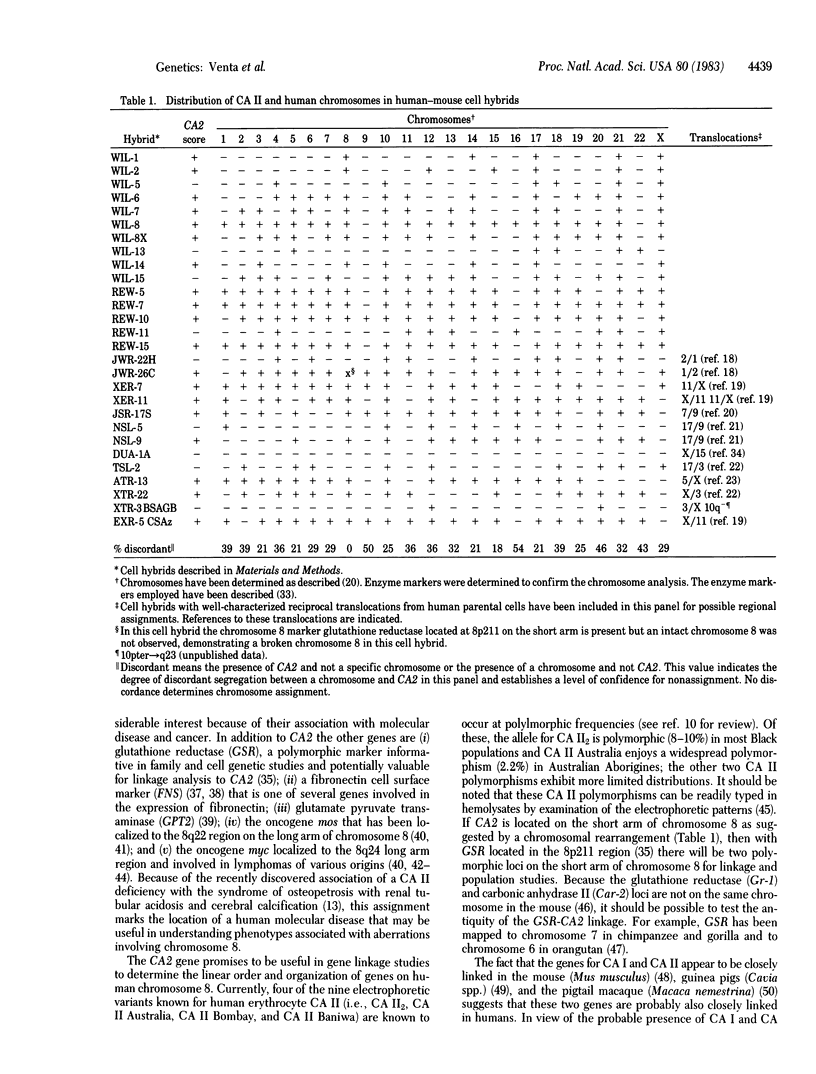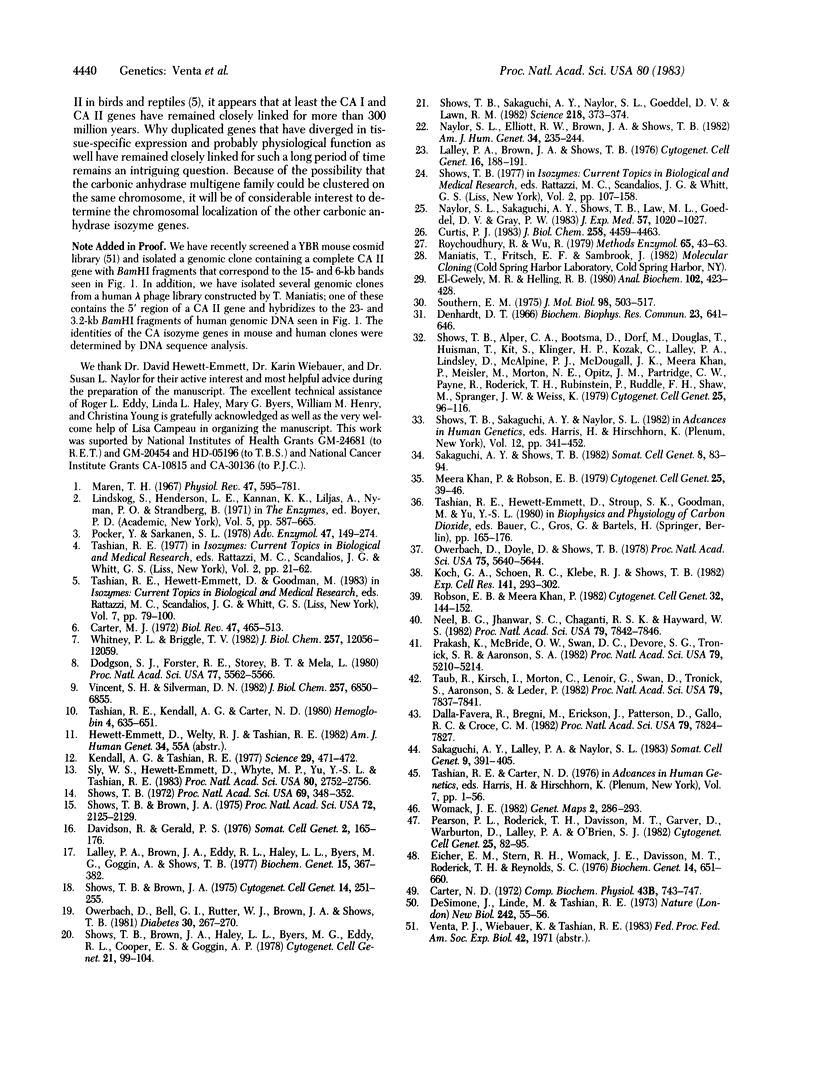Abstract
A panel of 28 mouse-human somatic cell hybrids of known karyotype was screened for the presence of the human carbonic anhydrase II (CA II) gene, which encodes one of the three well-characterized, genetically distinct carbonic anhydrase isozymes (carbonate dehydratase; carbonate hydro-lyase, EC 4.2.1.1). The human and mouse CA II genes can be clearly distinguished by Southern blot analysis of BamHI-digested genomic DNA with a mouse CA II cDNA hybridization probe. The two major hybridizing fragments in mouse were 15 and 6.0 kilobase pairs, and in human they were 15 and 4.3 kilobase pairs. Analysis of the somatic cell hybrids by this technique identified those containing human CA II gene sequences. Segregation analysis of the molecular marker and chromosomes in cell hybrids indicated a clear correlation between the presence of chromosome 8 and the human CA II gene (CA2). This finding provides the second polymorphic marker for human chromosome 8 and, moreover, a molecular disease marker, because human CA II deficiency has recently been linked to an autosomal recessive syndrome of osteopetrosis with renal tubular acidosis and cerebral calcification.
Full text
PDF



Images in this article
Selected References
These references are in PubMed. This may not be the complete list of references from this article.
- Carter M. J. Carbonic anhydrase: isoenzymes, properties, distribution, and functional significance. Biol Rev Camb Philos Soc. 1972 Nov;47(4):465–513. doi: 10.1111/j.1469-185x.1972.tb01079.x. [DOI] [PubMed] [Google Scholar]
- Carter N. D. Carbonic anhydrase isozymes in Cavia porcellus, Cavia aperea and their hybrids. Comp Biochem Physiol B. 1972 Nov 15;43(3):743–747. doi: 10.1016/0305-0491(72)90159-9. [DOI] [PubMed] [Google Scholar]
- Curtis P. J. Cloning of mouse carbonic anhydrase mRNA and its induction in mouse erythroleukemic cells. J Biol Chem. 1983 Apr 10;258(7):4459–4463. [PubMed] [Google Scholar]
- Dalla-Favera R., Bregni M., Erikson J., Patterson D., Gallo R. C., Croce C. M. Human c-myc onc gene is located on the region of chromosome 8 that is translocated in Burkitt lymphoma cells. Proc Natl Acad Sci U S A. 1982 Dec;79(24):7824–7827. doi: 10.1073/pnas.79.24.7824. [DOI] [PMC free article] [PubMed] [Google Scholar]
- Davidson R. L., Gerald P. S. Improved techniques for the induction of mammalian cell hybridization by polyethylene glycol. Somatic Cell Genet. 1976 Mar;2(2):165–176. doi: 10.1007/BF01542629. [DOI] [PubMed] [Google Scholar]
- DeSimone J., Linde M., Tashian R. E. Evidence for linkage of carbonic anhydrase isozyme genes in the pig-tailed macaque, Macaca nemestrina. Nat New Biol. 1973 Mar 14;242(115):55–56. doi: 10.1038/newbio242055a0. [DOI] [PubMed] [Google Scholar]
- Denhardt D. T. A membrane-filter technique for the detection of complementary DNA. Biochem Biophys Res Commun. 1966 Jun 13;23(5):641–646. doi: 10.1016/0006-291x(66)90447-5. [DOI] [PubMed] [Google Scholar]
- Dodgson S. J., Forster R. E., 2nd, Storey B. T., Mela L. Mitochondrial carbonic anhydrase. Proc Natl Acad Sci U S A. 1980 Sep;77(9):5562–5566. doi: 10.1073/pnas.77.9.5562. [DOI] [PMC free article] [PubMed] [Google Scholar]
- Eicher E. M., Stern R. H., Womack J. E., Davisson M. T., Roderick T. H., Reynolds S. C. Evolution of mammalian carbonic anhydrase loci by tanden duplication: close linkage of Car-1 and Car-2 to the centromere region of chromosome 3 of the mouse. Biochem Genet. 1976 Aug;14(7-8):651–660. doi: 10.1007/BF00485843. [DOI] [PubMed] [Google Scholar]
- El-Gewely M. R., Helling R. B. Preparative separation of DNA--ethidium bromide complexes by zonal density gradient centrifugation. Anal Biochem. 1980 Mar 1;102(2):423–428. doi: 10.1016/0003-2697(80)90177-3. [DOI] [PubMed] [Google Scholar]
- Kendall A. G., Tashian R. E. Erythrocyte carbonic anhydrase I: inherited deficiency in humans. Science. 1977 Jul 29;197(4302):471–472. doi: 10.1126/science.406674. [DOI] [PubMed] [Google Scholar]
- Koch G. A., Schoen R. C., Klebe R. J., Shows T. B. Assignment of a fibronection gene to human chromosome 2 using monoclonal antibodies. Exp Cell Res. 1982 Oct;141(2):293–302. doi: 10.1016/0014-4827(82)90217-8. [DOI] [PubMed] [Google Scholar]
- Lalley P. A., Brown J. A., Eddy R. L., Haley L. L., Byers M. G., Goggin A. P., Shows T. B. Human beta-glucuronidase: assignment of the structural gene to chromosome 7 using somatic cell hybrids. Biochem Genet. 1977 Apr;15(3-4):367–382. doi: 10.1007/BF00484467. [DOI] [PubMed] [Google Scholar]
- Lalley P. A., Brown J. A., Shows T. B. Assignment of hexosaminidase-B to chromosome 5, its segregation after diphtheria toxin selection, and the linkage of hexosaminidase-A, mannose phosphate isomerase, and pyruvate kinase (M2). Cytogenet Cell Genet. 1976;16(1-5):188–191. doi: 10.1159/000130587. [DOI] [PubMed] [Google Scholar]
- Maren T. H. Carbonic anhydrase: chemistry, physiology, and inhibition. Physiol Rev. 1967 Oct;47(4):595–781. doi: 10.1152/physrev.1967.47.4.595. [DOI] [PubMed] [Google Scholar]
- Meera Khan P., Robson E. B. Report of the committee on the genetic constitution of chromosomes 7, 8, and 9. Cytogenet Cell Genet. 1979;25(1-4):39–46. doi: 10.1159/000131398. [DOI] [PubMed] [Google Scholar]
- Naylor S. L., Elliott R. W., Brown J. A., Shows T. B. Mapping of aminoacylase-1 and beta-galactosidase-A to homologous regions of human chromosome 3 and mouse chromosome 9 suggests location of additional genes. Am J Hum Genet. 1982 Mar;34(2):235–244. [PMC free article] [PubMed] [Google Scholar]
- Naylor S. L., Sakaguchi A. Y., Shows T. B., Law M. L., Goeddel D. V., Gray P. W. Human immune interferon gene is located on chromosome 12. J Exp Med. 1983 Mar 1;157(3):1020–1027. doi: 10.1084/jem.157.3.1020. [DOI] [PMC free article] [PubMed] [Google Scholar]
- Neel B. G., Jhanwar S. C., Chaganti R. S., Hayward W. S. Two human c-onc genes are located on the long arm of chromosome 8. Proc Natl Acad Sci U S A. 1982 Dec;79(24):7842–7846. doi: 10.1073/pnas.79.24.7842. [DOI] [PMC free article] [PubMed] [Google Scholar]
- Owerbach D., Bell G. I., Rutter W. J., Brown J. A., Shows T. B. The insulin gene is located on the short arm of chromosome 11 in humans. Diabetes. 1981 Mar;30(3):267–270. doi: 10.2337/diab.30.3.267. [DOI] [PubMed] [Google Scholar]
- Owerbach D., Doyle D., Shows T. B. Genetics of the large, external, transformation-sensitive (LETS) protein: assignment of a gene coding for expression of LETS to human chromosome 8. Proc Natl Acad Sci U S A. 1978 Nov;75(11):5640–5644. doi: 10.1073/pnas.75.11.5640. [DOI] [PMC free article] [PubMed] [Google Scholar]
- Pearson P. L., Roderick T. H., Davisson M. T., Garver J. J., Warburton D., Lalley P. A., O'Brien S. J. Report of the committee on comparative mapping. Cytogenet Cell Genet. 1979;25(1-4):82–95. doi: 10.1159/000131403. [DOI] [PubMed] [Google Scholar]
- Pocker Y., Sarkanen S. Carbonic anhydrase: structure catalytic versatility, and inhibition. Adv Enzymol Relat Areas Mol Biol. 1978;47:149–274. doi: 10.1002/9780470122921.ch3. [DOI] [PubMed] [Google Scholar]
- Prakash K., McBride O. W., Swan D. C., Devare S. G., Tronick S. R., Aaronson S. A. Molecular cloning and chromosomal mapping of a human locus related to the transforming gene of Moloney murine sarcoma virus. Proc Natl Acad Sci U S A. 1982 Sep;79(17):5210–5214. doi: 10.1073/pnas.79.17.5210. [DOI] [PMC free article] [PubMed] [Google Scholar]
- Robson E. B., Meera Khan P. Report of the committee on the genetic constitution of chromosomes 7, 8, and 9. Oslo Conference (1981): Sixth International Workshop on Human Gene Mapping. Cytogenet Cell Genet. 1982;32(1-4):144–152. doi: 10.1159/000131694. [DOI] [PubMed] [Google Scholar]
- Roychoudhury R., Wu R. Terminal transferase-catalyzed addition of nucleotides to the 3' termini of DNA. Methods Enzymol. 1980;65(1):43–62. doi: 10.1016/s0076-6879(80)65009-5. [DOI] [PubMed] [Google Scholar]
- Sakaguchi A. Y., Lalley P. A., Naylor S. L. Human and mouse cellular myc protooncogenes reside on chromosomes involved in numerical and structural aberrations in cancer. Somatic Cell Genet. 1983 May;9(3):391–405. doi: 10.1007/BF01539146. [DOI] [PubMed] [Google Scholar]
- Sakaguchi A. Y., Shows T. B. Coronavirus 229E susceptibility in man-mouse hybrids is located on human chromosome 15. Somatic Cell Genet. 1982 Jan;8(1):83–94. doi: 10.1007/BF01538652. [DOI] [PMC free article] [PubMed] [Google Scholar]
- Shows T. B., Alper C. A., Bootsma D., Dorf M., Douglas T., Huisman T., Kit S., Klinger H. P., Kozak C., Lalley P. A. International system for human gene nomenclature (1979) ISGN (1979). Cytogenet Cell Genet. 1979;25(1-4):96–116. doi: 10.1159/000131404. [DOI] [PubMed] [Google Scholar]
- Shows T. B., Brown J. A., Haley L. L., Byers M. G., Eddy R. L., Cooper E. S., Goggin A. P. Assignment of the beta-glucuronidase structural gene to the pter leads to q22 region of chromosome 7 in man. Cytogenet Cell Genet. 1978;21(1-2):99–104. doi: 10.1159/000130882. [DOI] [PubMed] [Google Scholar]
- Shows T. B., Brown J. A. Human X-Linked genes regionally mapped utilizing X-autosome translocations and somatic cell hybrids. Proc Natl Acad Sci U S A. 1975 Jun;72(6):2125–2129. doi: 10.1073/pnas.72.6.2125. [DOI] [PMC free article] [PubMed] [Google Scholar]
- Shows T. B., Brown J. A. Mapping chromosomes 1 and 2 employing a 1/2 translocation in somatic cell hybrids. Birth Defects Orig Artic Ser. 1975;11(3):251–255. [PubMed] [Google Scholar]
- Shows T. B. Genetics of human-mouse somatic cell hybrids: linkage of human genes for lactate dehydrogenase-A and esterase-A 4 . Proc Natl Acad Sci U S A. 1972 Feb;69(2):348–352. doi: 10.1073/pnas.69.2.348. [DOI] [PMC free article] [PubMed] [Google Scholar]
- Shows T. B., Sakaguchi A. Y., Naylor S. L., Goedell D. V., Lawn R. M. Clustering of leukocyte and fibroblast interferon genes of human chromosome 9. Science. 1982 Oct 22;218(4570):373–374. doi: 10.1126/science.6181564. [DOI] [PubMed] [Google Scholar]
- Sly W. S., Hewett-Emmett D., Whyte M. P., Yu Y. S., Tashian R. E. Carbonic anhydrase II deficiency identified as the primary defect in the autosomal recessive syndrome of osteopetrosis with renal tubular acidosis and cerebral calcification. Proc Natl Acad Sci U S A. 1983 May;80(9):2752–2756. doi: 10.1073/pnas.80.9.2752. [DOI] [PMC free article] [PubMed] [Google Scholar]
- Southern E. M. Detection of specific sequences among DNA fragments separated by gel electrophoresis. J Mol Biol. 1975 Nov 5;98(3):503–517. doi: 10.1016/s0022-2836(75)80083-0. [DOI] [PubMed] [Google Scholar]
- Tashian R. E., Kendall A. G., Carter N. D. Inherited variants of human red cell carbonic anhydrases. Hemoglobin. 1980;4(5-6):635–651. doi: 10.3109/03630268008997733. [DOI] [PubMed] [Google Scholar]
- Taub R., Kirsch I., Morton C., Lenoir G., Swan D., Tronick S., Aaronson S., Leder P. Translocation of the c-myc gene into the immunoglobulin heavy chain locus in human Burkitt lymphoma and murine plasmacytoma cells. Proc Natl Acad Sci U S A. 1982 Dec;79(24):7837–7841. doi: 10.1073/pnas.79.24.7837. [DOI] [PMC free article] [PubMed] [Google Scholar]
- Vincent S. H., Silverman D. N. Carbonic anhydrase activity in mitochondria from rat liver. J Biol Chem. 1982 Jun 25;257(12):6850–6855. [PubMed] [Google Scholar]
- Whitney P. L., Briggle T. V. Membrane-associated carbonic anhydrase purified from bovine lung. J Biol Chem. 1982 Oct 25;257(20):12056–12059. [PubMed] [Google Scholar]



